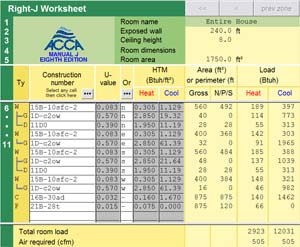Manual J HVAC Load Calculations
ACCA’s Manual J load calculation is part of the design process of a new HVAC system. By following the Manual J methodology, HVAC system designers are able to accurately determine the total amount of heat that is lost through the exterior of a home during the cooler months, and the total amount of heat that is gained through the exterior of a home during the warmer months. Through a series of calculations and inputs, the HVAC designer is able to analyze all aspects of the thermal characteristics of every wall, floor, ceiling, door and window. In addition, an HVAC load calculation also takes into consideration other factors such as the home’s geographic location, orientation to the sun, envelope tightness, duct leakage, lights and appliances. ACCA’s Manual J even calculates the amount of heat and humidity that each occupant of the house will add to the interior of the home.
Connor Air uses Wrightsoft’s Right-J software, an industry leading and ACCA-approved, Manual-J load calculation program.
Right-J is currently in use by tens of thousands of contractors and HVAC designers, providing them with the industry leading load calculation tools.
What does a Manual-J Load Calculation report actually provide?
A Manual-J load calculation report provides three main pieces of information regarding heating and cooling load:
- Heating Load: This is how much heat your house will require on the almost-coldest day of the year, in the middle of the night (when there’s no help from the sun). This is the number, or load, used to select a piece of heating equipment.
- Sensible Cooling Load: This is the amount of sensible heat (the type you measure with a thermometer) that your system should be able to remove on the almost-warmest day of the year, during the daytime (when the sun is heating up the building). This is used, IN COMBINATION WITH the next load-type, to select the cooling equipment.
- Latent Cooling Load: This load describes how much moisture your system should be able to remove under “worst-case” conditions. Worst-case for latent loads is typically when it’s hot and wet outside (daytime in the summer).

These three loads are used to select a piece of machinery that fits the loads (heat losses or gains) of your home. When selecting air conditioners or heat pumps, the two cooling loads should be used. And, the selected piece of machinery should be able to supply the proper amount of BOTH latent and sensible cooling, and be less that 15% over-sized, based on the Manual-J load calculation.This will ensure your system is capable of proper dehumidification (assuming the distribution system is performing properly).






